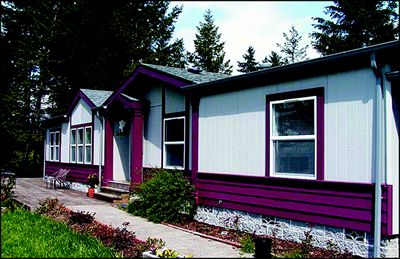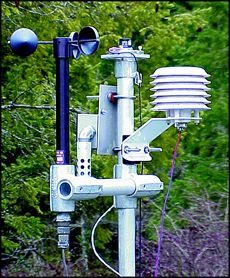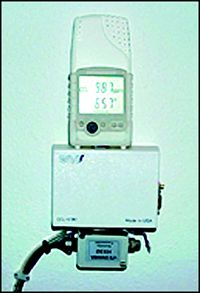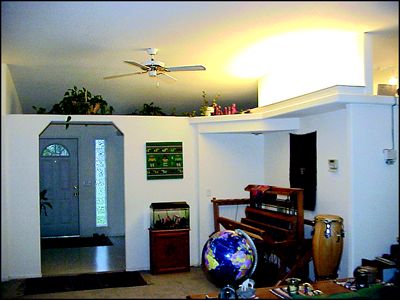WSU Energy House
Olympia,
WA
 The
Washington State University Energy House is believed to be
the most energy-efficient HUD-Code home in the USA. This 2,600-sq.
ft., triple-section home built by Moduline Industries, a division
of Champion Enterprises, was sited in early 1997 in Olympia,
WA. The WSU Energy House demonstrates cost-effective technologies
for the U.S. Department of Energy's Building America Industrialized
Housing Partnership (BAIHP).
The
Washington State University Energy House is believed to be
the most energy-efficient HUD-Code home in the USA. This 2,600-sq.
ft., triple-section home built by Moduline Industries, a division
of Champion Enterprises, was sited in early 1997 in Olympia,
WA. The WSU Energy House demonstrates cost-effective technologies
for the U.S. Department of Energy's Building America Industrialized
Housing Partnership (BAIHP).
BAIHP and WSU are currently monitoring energy performance in this home. All data is downloaded daily to FSEC via modem. Detailed data queries and graphs can be generated through FSEC's WebGet database.
The BAIHP is monitoring energy end-usage, temperature, RH, pressure, HVAC operation, CO2 concentrations and weather. It is also a test bed for indoor air quality and ventilation system effectiveness research. The home is built beyond the Super Good Cents (SGC)/Natural Choice (NC) manufactured housing program, using Energy Star appliances, lighting, HVAC and a solar domestic hot water system. Energy Star appliances, lighting and heat pumps/gas furnaces are not options available to most SGC/NC homebuyers.
 |
Left:
Right: |
 |
The overall energy package including lighting, appliances and HVAC (w/o Solar DHW) cost $6,416, and saves $900 per year in power bills (at 6.5 cents per kwh). This creates a quick return on investment. For the WSU Energy House's 8%, 30-year loan, the energy savings reduces the monthly payment by $28 per month. This results in a net savings of $336 per year at current energy costs. In addition, the NADA appraisal guide used to value manufactured homes indicates an additional $1,573-$3,420 resale value for a certified SGC home.
The thermal envelope cost $2,600 over minimum HUD Code and saves $373 in a typical year at 6.5 cents per kWh The table below provides an overview of how the WSU Energy Home insulation levels compare to HUD and SGC standards.
Improved ductwork includes the following, which increases HVAC distribution system efficiency by 10-15%: Center section ductwork was eliminated, reducing one third of duct heat-loss and air leakage. Foil faced butyl duct tape and mastic is used to seal duct joints. R10 rigid foam was used to better insulate splitter boxes. R8 crossover ducts were used instead of R4 crossover ducts kept off the ground with 1" R5 foam. Duct leakage tests were conducted to find and seal duct leaks. Additional ductwork sealing planned using an aerosol duct-sealing system.
Energy Star windows offer several advantages. Vinyl frame windows contain low-e coating and argon gas filled. Low-E increases occupant comfort while reducing UV damage to carpet and furniture. Vinyl windows reduce condensation and mold accumulation when compared to aluminum windows.
Two whole-house ventilation systems are installed. One system uses a very quiet 22-watt exhaust fan, while the other uses a noisy 350-watt furnace blower and outside air duct to the furnace return. The analysis of energy, ventilation and indoor air quality performance of these systems is underway. Innovative control strategies will be tested to further minimize energy use and occupant exposure to indoor air pollution.
Blower door testing was conducted to locate and repair in-plant, transport and setup related air leakage measures. While the homes tested very tight, a few minor leaks were discovered and repaired around tub enclosures, doors and fireplace vent.
Supply air register dampers were balanced using a flow hood to deliver the proper heat to each zone and to avoid comfort problems associated with isolated rooms located away from the thermostat. A radiant heating panel is installed in the master bathroom to heat this zone without using the furnace or relying on the waste heat created by bathroom vanity bulb fixtures.
The lighting retrofit of Energy Star lighting and fixtures reduced total lighting wattage by over 2,000 watts. The fixture retrofit cost $766 and saves $86 per year in electric bills. Bathroom vanity and porch light fixtures provided the greatest energy savings at least first cost. In almost four years no light bulbs have been replaced and lighting quality has improved. The package includes warm-white lighting using: Dimmable T-8 fluorescent fixtures in plant-ledge areas; T-8 fluorescent fixtures over kitchen counters; Energy Star ceiling fixtures; T-8 fluorescent bathroom vanities; 13 Watt Energy Star porch light fixtures with photo cells; Compact fluorescent (CFL) bulbs in table and floor lamps.

(The special fluorescent lighting used in the home to produce lower energy usage.)
Energy Star dishwasher, clothes washer and refrigerator were installed in the home aftermarket, since the manufacturer could not provide Energy Star appliances as an option, at an incremental cost of $450. The appliances save $67 per year, not including clothes washer savings in water, septic, fabrics and soap.
A zero-clearance propane fireplace can provide most space heating needs. Since the fireplace is totally enclosed within the building envelope, it has minimal standby and cool-down heat loss, and no duct losses. Ceiling fans in the main living and kitchen area circulate heat from the fireplace throughout the home. The gas fireplace can operate during power outages and be thermostatically controlled to operate instead of heat pump in strip-heat mode.
An Energy Star air source Insider heat pump was installed in the summer of 2000. Thermal monitoring will determine heat pump energy savings. The heat pump reduces space heat usage by 40-50%, costs less than $2,500 installed and saves $373 per year. This Insider heat pump can be totally installed at the plant.
For solar hot water, a two panel flat plate solar collector and heat exchanger module was installed in the summer of 2000, to provide 30-40% of the domestic water-heating. The solar retrofit will help BAIHP evaluate the benefits of a concept called 'Solar Ready.' A Solar Ready manufactured home would have solar pre-plumbing, roof mounting and flashing installed at the plant to facilitate an after market installation. The Solar Ready option will lower installation costs and ensure that after market retrofits are done in accordance with the HUD Code.
© Copyright 2000. Reprinted from the October 2000 Edition of Automated Builder Magazine with the permission by the publisher.
System |
HUD Minimum |
SGC |
Energy House |
Roof Insulation |
R-22 |
R33-R49 |
R38-R49 |
Wall Insulation |
R11-R19 |
R19-R21 |
R21 |
Floor Insulation |
R11-R22 |
R33 |
R33 |
Windows |
U=0.45* |
U=0.37** |
U=0.34*** |
Doors |
No Standard |
Foam Core |
Foam Core |
Air Leakage |
Little Attention |
Detailed Sealing |
Improved Sealing + Tests |
Ventilation |
Furnace |
Whole House Fan |
Both Systems + Tests |
Crossover Ducts |
R4 |
R8 |
R8 +R10 splitter |
Marriage Line |
Limited Req. |
Well Sealed |
Well Sealed + Tests |
*Clear aluminum/vinyl **Vinyl low-E ***
Vinyl low-E/AR |
|||
Related
Resources..
Efficient Manufactured Housing Brochure (PDF
331kB)
Home
Ventilation Brochure (PDF
300kB)
Quality
Control for Manufactured Housing in the Northwest (MSWord
12kB)
